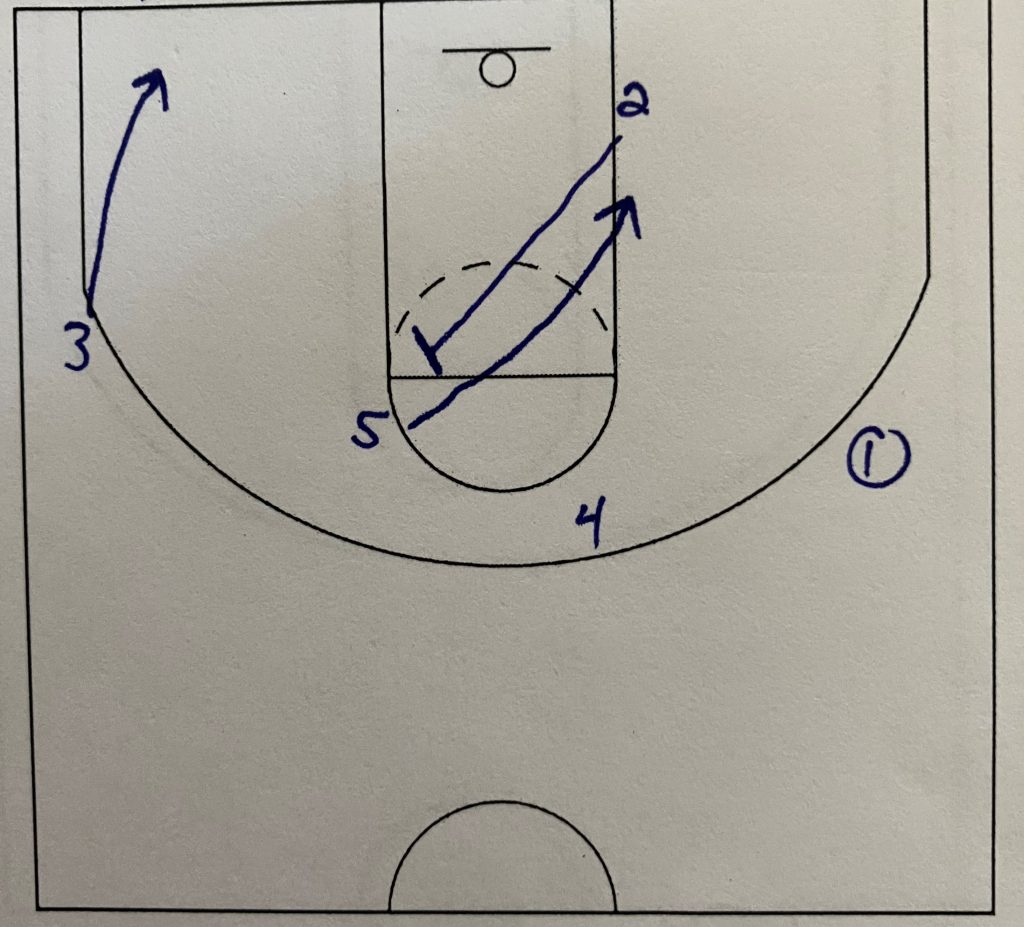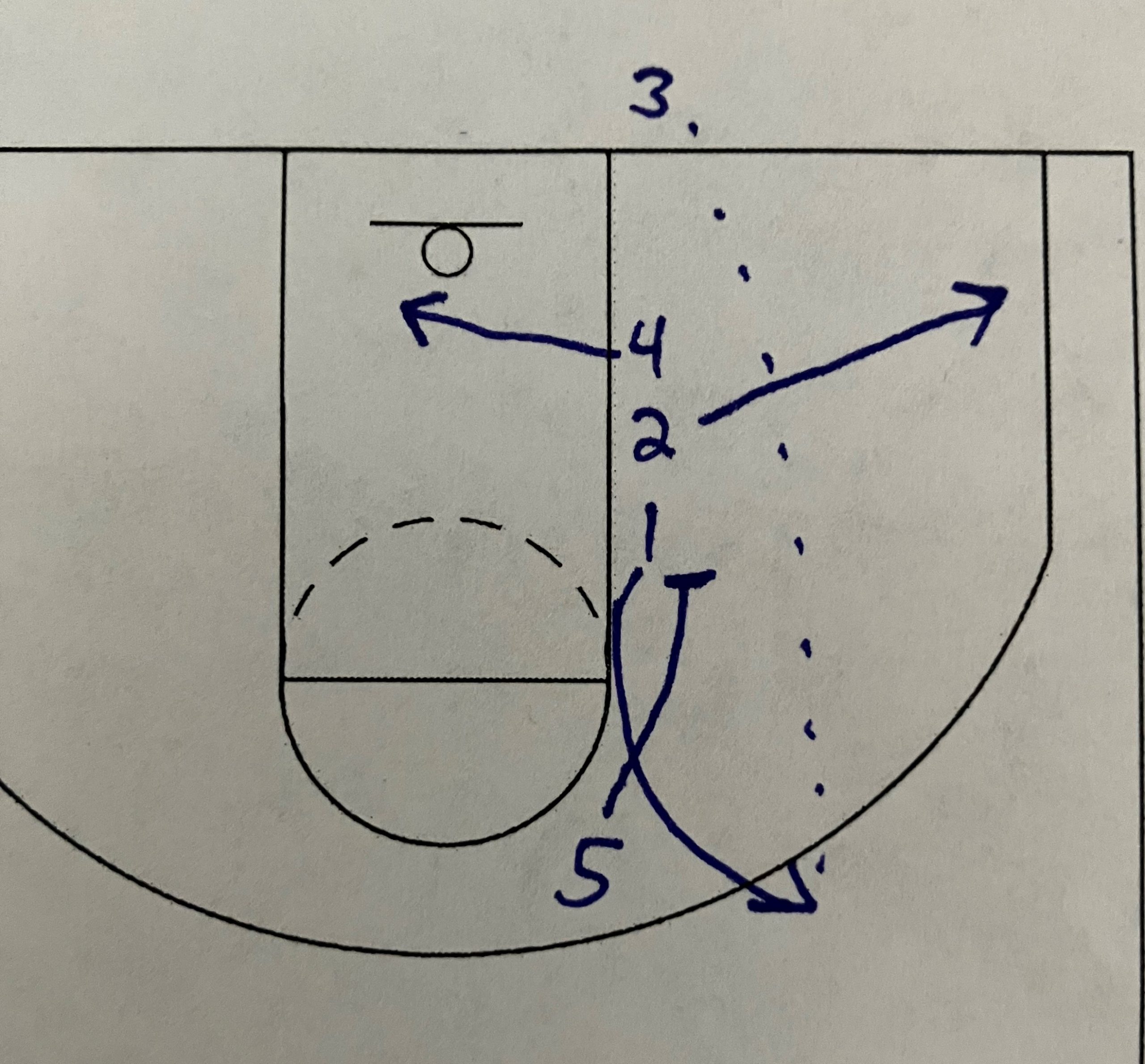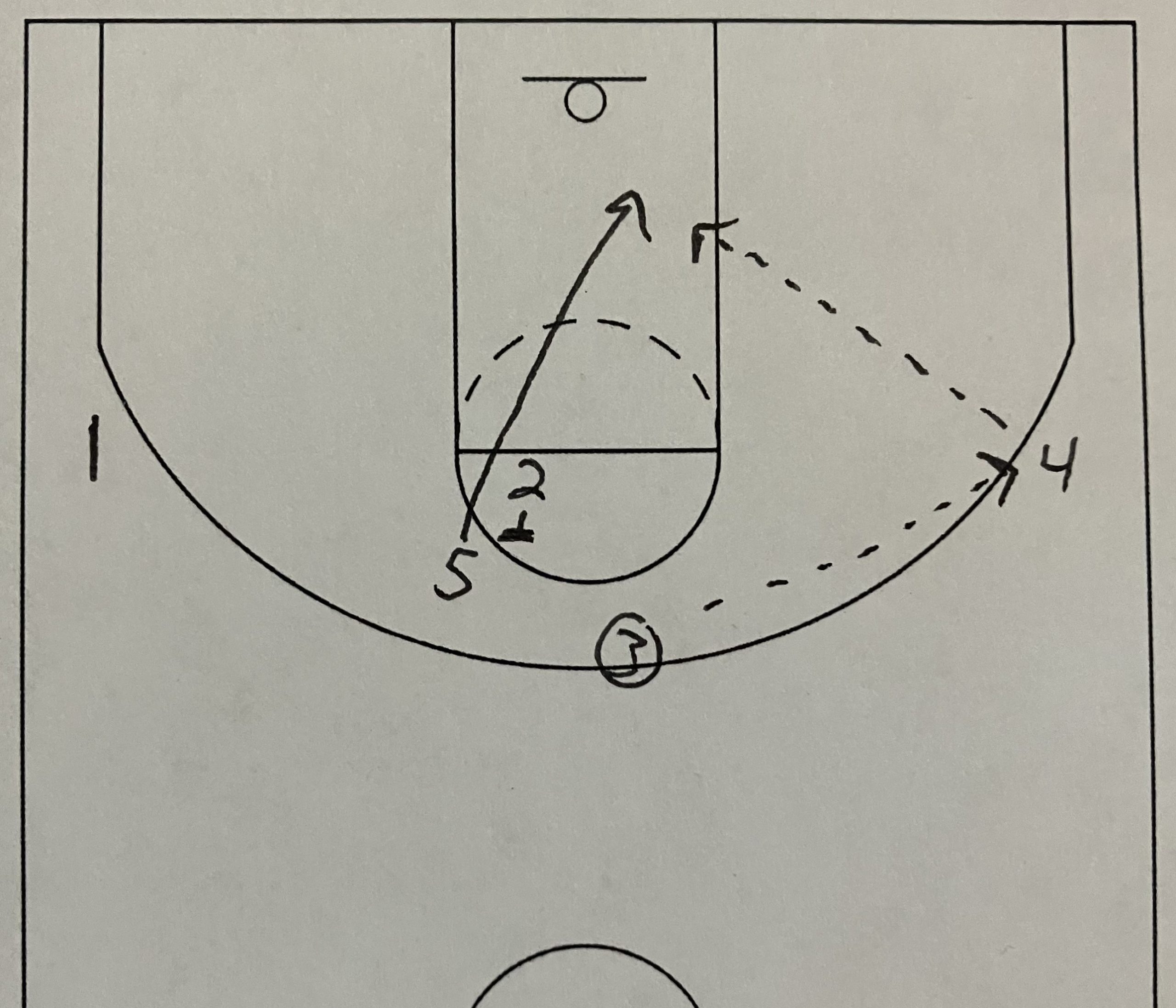I always like a quick hitter that has multiple options to score. These plays do not have a set person getting the ball to score. The breakdown in defense will give the offense the read on where to pass the ball and who will get the shot. By having multiple options on plays, the defense is never able to overplay the quick hitter because any overplay will lead to an open shot elsewhere.
Along with multiple scoring options I also like plays that are relativity simple in concept. I want the players reading and reacting and not thinking about what they are doing. A few simple movements and reads are all that is needed. Each player has one or two movements and reads so no player should have too much information to process. Too much thinking leads to slow play. I want the players reading and reacting and playing fast.


The start of the play is out of a 1-4 High Set. This pulls all of the defense up and away from the basket. This helps to prevent a defender from just standing at the basket making it hard for the offense to get to the rim. By elevating the offense, the defense has to come up away from the baseline as well.
The first movement of this play is a ball screen. This can be ran to either side of the court. All of the players just switch if it is ran to the left. In the diagram, the big(4) sets the initial ball screen for the point(1).
As the point(1) starts dribbling to the wing, the guard(2) is cutting to the basket. The guard(2) needs to take their cut all the way to the basket to give them a better angle on their backscreen. If the guard(2) does not get a pass on the back cut, they will come up and set a backscreen for the center(5). The center(5) should take a step out to the slot to give the guard(2) a better angle as well.
As the guard(2) comes up the lane for the backscreen, the point(1) has the chance to beat their defender off the dribble and get to the basket. If the point(1) can turn the corner off of the ball screen, then no defender will be there to help because of the ball screen and back screen both taking place. Every defender is occupied with a screen except for the forward’s(3) defender on the other side of the floor. That defender is too far away to help.
If the point(1) does not get a back cut to the guard(2) or a layup off the ball screen then they are back dribbling out to the wing. The point(1) is now looking for the center(5) coming across the lane off of the back screen. The point(1) is reading the center(5) all the way down the lane and giving the center(5) a chance to get a post up isolation once the center(5) gets to the block.
If the offense does get a shot off of the 1st 3 scoring options, then the 2nd movement of the offense happens. To recap before the 2nd movement…
Scoring Option #1
The backdoor cut by the guard(2) as the ball screen is being set.
Scoring Option #2
The point(1) is able to turn the corner off of the ball screen and get to the basket as the guard(2) is setting the backscreen for the center(5).
Scoring Option #3
The center(5) gets a pass either on the cut off of the backscreen or gets an iso post feed once the center(5) finishes the cut.


The last scoring option is an away screen for a player coming back towards the ball. I have used both variations and they both work.
Single Screen
The left diagram is a single away screen set by the big(4) for the guard(2) coming back to the ball. This completes a screen the screener action. A team that really helps and checks off of back screens will have a hard time guarding screen the screener actions. A good center(5) that pulls the focus of the defense with them makes the single screen a better choice.
The single screen makes the defense stay closer to the center(5) and help more on the back screen. This gives the space for the guard(2) to come open immediately after the back screen. The better back screen the guard(2) sets for the center(5), the more help the defense will need to give which gives the guard(2) more of a chance to come open off the screen the screener action.
Double Screen
The double screen gets all 5 offensive players involved in the quick hitter. This puts more pressure on every defender because a breakdown by any player should give the offense a shot. I also liked to run the double screen when the guard(2) and forward(3) are both good shooters. The double screen gives them more of a chance to lose their defender and come open at the top of the key.
In the double screen, the guard(2) and big(4) set a stagger screen after the ball screen, back screen actions. The forward(3) steps into the short corner area and then runs up around the stagger double screen.
I always use a stagger double here because I want the screens being on the backside of the court. If the forward(3) is a good shooter and the defense is chasing behind on the double screen, then the more the guard(2) and big(4) can get across the midline for the double screen the more room the forward(3) has to curl around the 2nd screen and get the ball into the lane if needed.
The stagger forces the defender to chase longer around giving the forward(3) more of a chance to curl. A shoulder to shoulder double screen is going to be closer to the midline cutting the space the forward(3) could use on the curl cut. And the non-stagger double is easier to chase around then a stagger double.
Scoring Option #4
A 3-point shot either by the guard(2) coming off of a single screen away or by the forward(3) coming off of a double stagger screen.
Conclusion
This play is versatile. I have used it with a quick point guard to get rid of the help and let them get downhill off of a ball screen. I have used it to isolate a post player. I have used it to get a shooter open at the top of the key.
The offensive focus of the team can change every season but the play can continue to be used because another scoring option will become more of the key of the offense. One season I had a quick point(1) who scored all the time by being faster than the defense. The next season I had a shooter and we ran it all the way through to get him the open 3-point shot.
The team dynamic will help to dictate where the offensive scoring options are going to come from the most. While I have had the players focus on trying to get a certain scoring option more than the others, I have never had a team that this play was not an option. This is a play that can be ran from the youth level all the way up to the varsity level and have it work over and over and over again.




